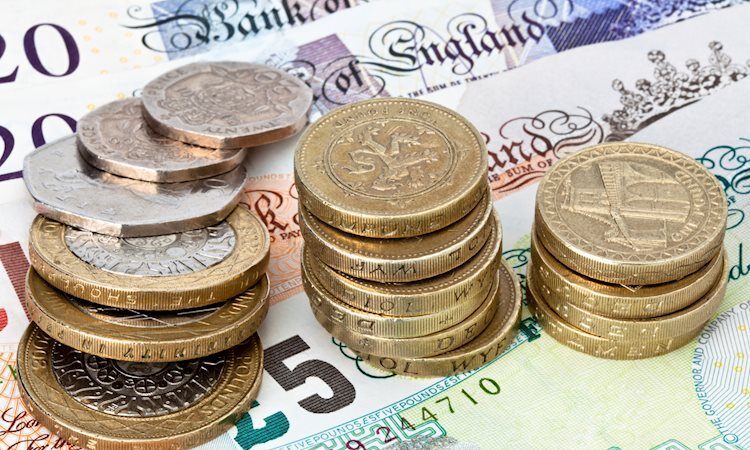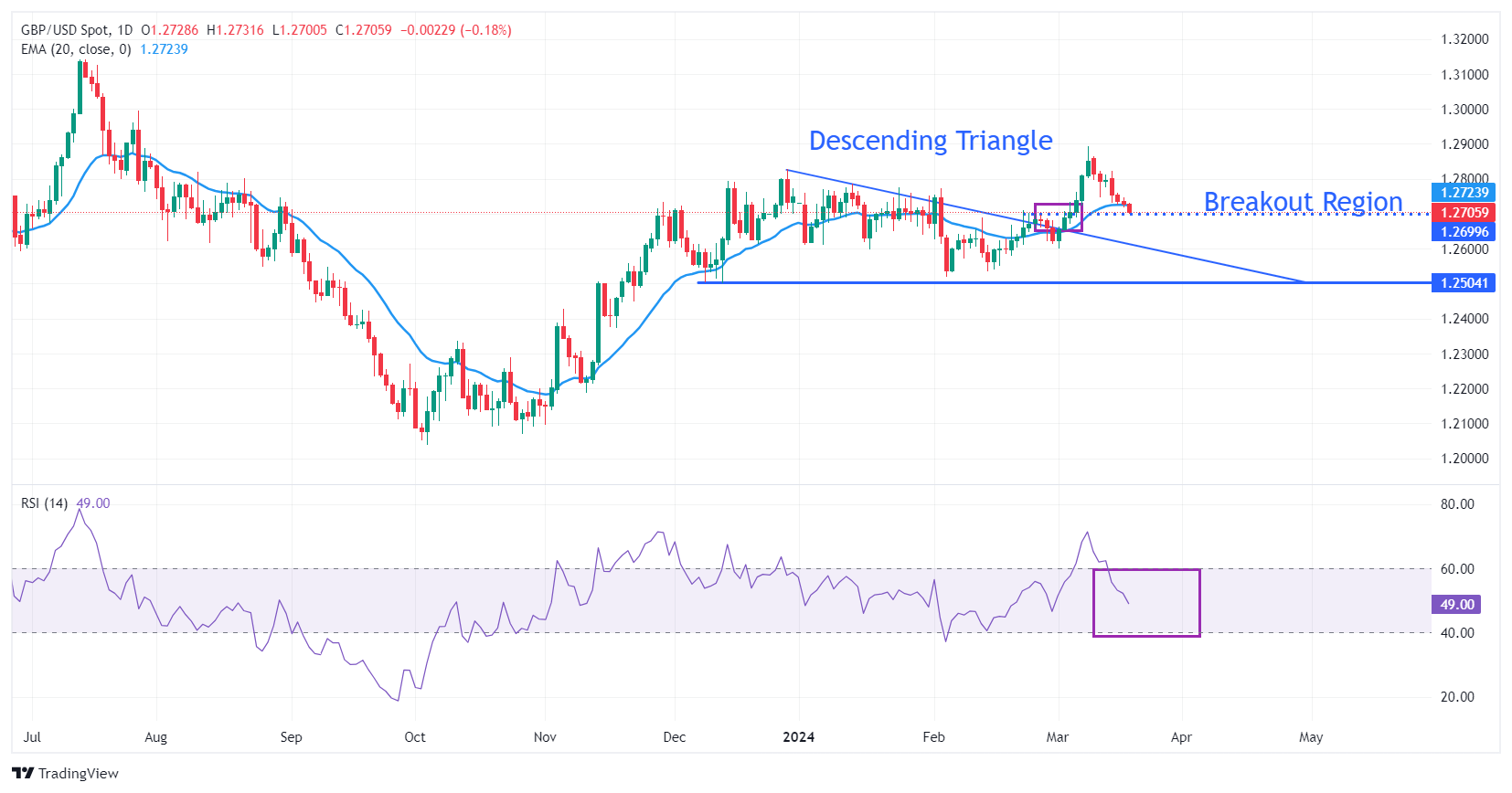
- The Pound Sterling refreshes a weekly low near 1.2670 amid a risk-averse mood.
- The UK Inflation data will influence market expectations for BoE rate cuts in August.
- Investors see the Fed and the BoE holding interest rates at their current levels.
The Pound Sterling (GBP) continues its losing streak for the fourth trading session on Tuesday as investors turn risk-averse in a big central banks’ week. The GBP/USD pair prints a fresh weekly low ahead of the interest rate decisions by the Federal Reserve (Fed) and the Bank of England (BoE). As both central banks are anticipated to maintain the status quo, investors will majorly focus on clues about the interest rate outlook.
In the United Kingdom, investors will scrutinize the BoE’s monetary policy statement to look for any cues about the timing for interest-rate cuts. UK headline inflation has come down significantly from the double-digit figures to 4%, mainly because the BoE has raised and kept interest rates at high levels for more than two years. Maintaining higher interest rates has also led to a sharp decline in economic growth, uplifting expectations for rate cuts in August.
Before the BoE policy decision, market participants will focus on the UK Consumer Price Index (CPI) data for February, which will be published on Wednesday. Expectations for the BoE to lower interest rates sooner could escalate if the inflation data turns out softer than expected. On the contrary, stubborn data will deepen uncertainty over rate cuts. The Pound Sterling tends to strengthen when inflation data comes in higher than expected, suggesting BoE policymakers will maintain a hawkish narrative.
Daily digest market movers: Pound Sterling remains on backfoot on dismal market mood
- The Pound Sterling drops below the round-level support of 1.2700 as dismal market sentiment has dampened the appeal of risk-sensitive assets. The risk appetite of investors has diminished ahead of a slew of central bank meetings this week. “Investors are uncertain that the Fed will start cutting rates in June, as markets previously widely expected, due to recently hot inflation data. This has weakened the appeal for risk assets.
- The demand for safe-haven assets has improved significantly. The US Dollar Index (DXY), which measures the US Dollar’s value against six rival currencies, continues its winning streak for the fourth trading session on Tuesday. The USD Index jumped to 104.00 on hopes that the Fed will maintain hawkish rhetoric after keeping interest rates unchanged in the range of 5.25%-5.50% on Wednesday
- This week, the Pound Sterling will be guided by the Bank of England’s interest rate decision, which will be announced on Thursday. The BoE is widely anticipated to keep interest rates unchanged at 5.25%. Therefore, investors will keenly focus on cues about when the BoE is expecting to start reducing interest rates. Currently, the market expects the BoE to begin reducing interest rates in its August policy meeting.
- The market expectations for a rate cut in August are expected to be influenced by the United Kingdom CPI data for February, which will be announced on Wednesday. The annual headline inflation is forecast to have fallen to 3.6% against 4.0% in January. In the same period, core inflation – which excludes volatile food and energy prices – is forecast to have decelerated to 4.6% from 5.1%. For the monthly headline CPI, economists have forecasted a sharp growth of 0.7% after declining by by 0.6% in January.
Technical Analysis: Pound Sterling refreshes weekly low at 1.2670
The Pound Sterling falls below the breakout region of the Descending Triangle formed around 1.2700. The near-term demand for the GBP/USD pair has turned uncertain as it has dropped below the 20-day Exponential Moving Average (EMA), which trades around 1.2730.
On the downside, the downward-sloping border of the Descending Triangle chart pattern could support the Pound Sterling. On the upside, a seven-month high at around 1.2900 will be a major barricade.
The 14-period Relative Strength Index (RSI) returns to the 40.00-60.00 range, indicating a sharp volatility contraction.
Risk sentiment FAQs
In the world of financial jargon the two widely used terms “risk-on” and “risk off” refer to the level of risk that investors are willing to stomach during the period referenced. In a “risk-on” market, investors are optimistic about the future and more willing to buy risky assets. In a “risk-off” market investors start to ‘play it safe’ because they are worried about the future, and therefore buy less risky assets that are more certain of bringing a return, even if it is relatively modest.
Typically, during periods of “risk-on”, stock markets will rise, most commodities – except Gold – will also gain in value, since they benefit from a positive growth outlook. The currencies of nations that are heavy commodity exporters strengthen because of increased demand, and Cryptocurrencies rise. In a “risk-off” market, Bonds go up – especially major government Bonds – Gold shines, and safe-haven currencies such as the Japanese Yen, Swiss Franc and US Dollar all benefit.
The Australian Dollar (AUD), the Canadian Dollar (CAD), the New Zealand Dollar (NZD) and minor FX like the Ruble (RUB) and the South African Rand (ZAR), all tend to rise in markets that are “risk-on”. This is because the economies of these currencies are heavily reliant on commodity exports for growth, and commodities tend to rise in price during risk-on periods. This is because investors foresee greater demand for raw materials in the future due to heightened economic activity.
The major currencies that tend to rise during periods of “risk-off” are the US Dollar (USD), the Japanese Yen (JPY) and the Swiss Franc (CHF). The US Dollar, because it is the world’s reserve currency, and because in times of crisis investors buy US government debt, which is seen as safe because the largest economy in the world is unlikely to default. The Yen, from increased demand for Japanese government bonds, because a high proportion are held by domestic investors who are unlikely to dump them – even in a crisis. The Swiss Franc, because strict Swiss banking laws offer investors enhanced capital protection.





